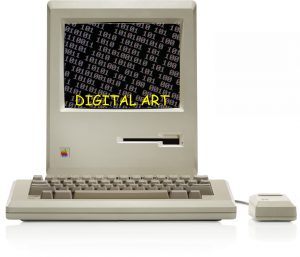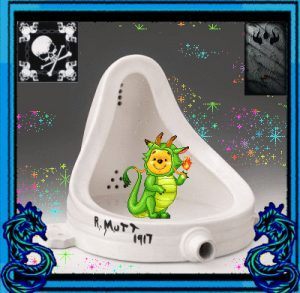by Nickolas Calabrese

The subject of digital art is unclear. Work that was new five years ago can look ancient now because of the constant changes in technologies. The term “digital art” itself is an umbrella term that applies to a variety of names for art that is produced with the aid of a computer including, but is not limited to, “new media art”, “net art”, and “post internet art” (for a fuller linear history of the various terms that denote art made with or assisted by computers, see Christine Paul’s terrific introduction to A Companion to Digital Art reader, which she edited). The decision to use “digital art” is twofold. First, some of the alternatives only denote a temporal category while not actually referring to the form (new media can only be “new” for a brief period; it makes little sense for a “post internet” when it hasn’t significantly evolved from “net art”; put more brusquely, in the words of critic Brian Droitcour in Art in America magazine “most people I know think “Post-Internet” is embarrassing to say out loud”); and second, because I regularly teach an undergraduate visual arts course at NYU named Digital Art (a title I did not choose).
The upshot of digital art’s classification is that it might not actually exist as a category.
This might sound like trolling, but there are good reasons if we consider what the term tells us. It is generally used to designate a category of art, but really it just refers to a tool (a computer) that is used somewhere in the process of production. Even then it’s an inadequate term because it doesn’t really refer to that tool, but rather the coding that makes up an image, a video, an application, etc. The irony about its mischaracterization is that digital art is only ever seen on something that is decidedly not digital, that is, on a physical object. This might be your phone, your desktop, an image printed on paper, a projector, and so on. One can see this more easily by thinking about the distinction between digital and analog. Analog technologies are those technologies that have an analog for measurement of data. So too a vinyl record, with its grooves embedded during a recording, serves as an analog for the music it plays. And an analog watch, with hands and gears, represents a physical measurement of time. Analog technologies are those that have physical counterparts to quantify the data that they are representing.
Digital technologies, on the other hand, are 0s and 1s used to represent data (I’m not a computer scientist, and I’m sure that things are significantly more complex than this, but for the case of digital art, let’s go with it). Digital data is immaterial, save for the computers and servers that host the data. There are no gears in the digital watch – the time in a digital watch is a sequence of 0s and 1s, coded so as to retrieve the time. It is a technology of commands, whereas analog technology is a technology of consistent functioning. Of course there are similarities between the two, but the difference is important. What is digital about digital art is the data that comprises it along with a device to input and retrieve that data. A computer itself is noticeably not digital, it’s a chunky metal, plastic, and glass object. Digital art is just shorthand for saying, a computer was used in the process of making this thing. Consider other forms of art, like painting, sculpture, photography; each of these has a 1:1 corresponding object with its media. A painting is made out of paint on a surface, a sculpture is made out of sculpted materials, a photograph is a negative which is then used to print the photograph.

But data is deviant. You might begin by producing something with a computer, much as the text you are currently reading was produced with, and then you figure out a way to extract that immaterial stuff to show it in the world. In a way, the natural process of making this kind of art, unlike painting, sculpture, and photography, is that of undigitzing it for its final presentation. There is another peculiar issue the digital artist faces – that their media is ephemeral. They are complicit in their own obsolescence because unlike the painter who has millennia of tradition, they must constantly seek out newer technology in order to stay relevant in their medium. When they lag behind they appear as a relic – even if their technological engagement is only dated by a few years. Just look at some of the luminaries in this field like JODI or Corey Arcangel: some of their works from just a decade ago look antique.
Three not so uncontroversial conditions for art generally and digital art specifically might be useful for present purposes. (1) Getting to know art is predicated on physical experiences of it. Even John Cage’s 4’33”, which was precisely four minutes and thirty-three seconds of an orchestra doing diddly-squat, requires the audience to be there and experience it, no matter how conceptual it might be. Being there, as it were, is what proves the concept. (2) Experience is predicated on things. If you lived in a vacuum, you would assumedly have no experience, or at last none worth a damn. While it is true that a thought is a thing, it is also the case that a thought requires a mode of expression (as an artwork in our current case), and the moment that expression happens it becomes physical (meaning there is some kind of record of it). The moment a bit of data is expressed (through a computer for instance) it has been materialized into a thing in the world. (3) Digital, in relation to art, is a matter of tools and their efficacy, not of artworks themselves. We don’t casually speak of painting as “painted art”, just as an artwork. “Computer”, in reference to art, is more like “paintbrush”, “table saw”, or “camera”: it is a thing that we can use to make other things, but it is not the final product; and “digital” is like “paint”, “wood”, or “film”. This last one is subtle but important, because it seems that digital artworks are frequently members of these other classes of artworks; so much so, that I cannot really think of an artwork that is strictly digital without being something else more primarily.
A lot of what we call digital art is most frequently examples of sculpture, photography, printmaking, and even publishing. Their sort of disembodied form (meaning you can do something like extract the data that comprises the artwork and email the file to a friend) and presentation make digital artworks more approachable and more accessible. For instance, one of Arcangel’s more celebrated works, Super Mario Clouds (2002), is easily seen on the internet. When it is exhibited it comes in the form of a Super Nintendo playing the cartridge that he hacked to show only the clouds from the popular video game Super Mario Bros. Now what is this actually? It appears to be a sculpture and a video at once, but not, strictly speaking, a digital artwork. Or consider when artists like Josh Kline use 3D modeling software to produce an object – it seems closer to a print or a sculpture. Or Petra Cortright’s YouTube selfie videos made with her webcam; these must be considered performance-based video works. Yet all three of these artists are given one of those labels placing the computer at the forefront of what they do.
It might be wise to look back a century to mathematician and philosopher Gottlob Frege in an effort to grapple with this. Frege’s definition of what numbers are is particularly useful in understanding and talking about artworks. For Frege, the thing ‘4’ has no physical objecthood. That is, it isn’t a thing that exists in the world independently of things it is representing a quantification of. He says it is mistaken to try and understand what ‘4’ means outside of a particular context; or more specifically, outside of a sentence. So we can only know ‘4’ by knowing ‘4 horses’ for example. He was committed to using the concept of numbers to determine a larger concept of language. Frege’s assertion that numbers can only be semantically described in the context of a sentence can be extended to art. Accounting for how we understand immaterial elements of life in the physical world is similar to what digital art is like, because we can only comprehend digital artworks once they have been expressed in things. They depend on actualization in non-digital forms. The data has no existence outside of it’s expression in physical form – and this usually brings us back to one of those established art forms that already exists.
If the computer is just another tool that can be used for making art, why isolate it from the others? Making art with computers comes complications. The main one for artists engaging this media has to do with their livelihood: it is more difficult to sell digital art. Some have tried to make online services that sell digital files, like Monegraph, which uses the same blockchain technology as Bitcoin in an attempt to monetize these files (it was created by an artist, not incidentally). But these services are not the standard-bearer of making sales in the art world, constituting just bits of the larger art economy, which is founded on gallery sales and resale auction houses like Sotheby’s. The topic deserves, and has, several volumes dedicated to it, so I won’t even try. But perhaps if the definition of this type of art is more representative of what it appears as in its final form, then it can be evaluated more fairly.

None of this is a dig at the work we refer to as digital art. We live in a society where we can never go back from computers: the human race will endbefore the internet ends. In a witty passage about data where he quotes from Tristan Tzara talking about Dada, Byung-Chul Han writes that “data and numbers are not narrative; they are additive. Meaning, on the other hand, is based on narration. Data simply fills up the senseless void (Psychopolitics, 59)”. Like Dada’s artworks, which Tzara took, among other things, to mirror the senseless way that events in life just happen; those artworks predicated on data are nothing without their modes of expression. If a painter gets all of her images from google searches, and then paints them faithfully, is she a digital artist? Are there any artists these days who don’t use a computer at any stage in their work at all? If data is what fills the senseless void of life, then why suggest it is its own form? What it actually does is fill form, which in turn gives that data structure. Data is content, and content is, to this author’s mind, essential to works of art. Its form is something else, also essential, that should be treated as something else – the form is what dictates the classification of art-forms.
